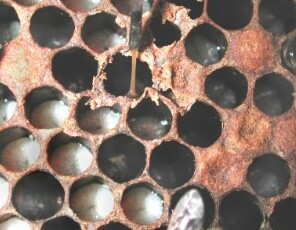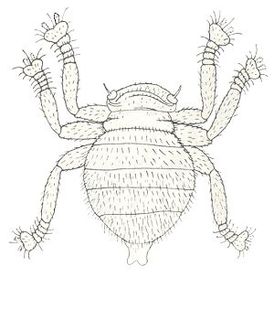 W
WAcarapis woodi is an internal parasite affecting honey bees, the symptoms of infestation was originally observed on the Isle of Wight in 1904, but was not described until 1921. Acarapis woodi mites live and reproduce in the tracheae of the bees. The symptoms of Acarapis woodi infestation were originally called by beekeepers as the Isle of Wight Disease, however it is now called Acarine, after the Subclass to which the mites belong. All mites are arachnids like spiders. The female mite attaches 5–7 eggs to the tracheal walls, where the larvae hatch and develop in 11–15 days to adult mites. The mites parasitize young bees up to two weeks old through the tracheal tube openings. There, they pierce the tracheal tube walls with their mouthparts and feed on the haemolymph of the bees. More than a hundred mites can populate the tracheae and weaken the bees. The mites are generally less than 175 micrometres (0.007 in) long, and can only be seen and identified under a microscope.
 W
WAmerican foulbrood, caused by the spore-forming bacteria Paenibacillus larvae ssp. larvae, is a highly infectious bee disease. It is the most widespread and destructive of the bee brood diseases.
 W
WBraula is a genus of flies (Diptera) in the family Braulidae or bee lice. These are very unusual flies, wingless and flattened, and barely recognizable as Diptera. Braula coeca Nitzsch is a pest of honey bees. The larvae tunnel through the wax honeycomb and the adults are found on the bodies of honey bees. There is some debate as to whether the bee louse causes damage to the honey bee. These flies sometimes can be found at places where bees congregate such as flowers or salt licks, waiting to grab onto hosts from uninfested nests. Braula is cosmopolitan and about 1.6 mm in length.
 W
WDeformed wing virus (DWV) is an RNA virus, one of 22 known viruses affecting honey bees. While most commonly infecting the honey bee, Apis mellifera, it has also been documented in other bee species, like Bombus terrestris, thus, indicating it may have a wider host specificity than previously anticipated. The virus was first isolated from a sample of symptomatic honeybees from Japan in the early 1980s and is currently distributed worldwide. It is found also in pollen baskets and commercially reared bumblebees. Its main vector in A. mellifera is the Varroa mite. It is named after what is usually the most obvious deformity it induces in the development of a honeybee pupa, which is shrunken and deformed wings, but other developmental deformities are often present.
 W
WSlow bee paralysis virus (SBPV) is a virus discovered in England in 1974 that infects honeybees, bumblebees, and silkworms through Varroa destructor mite infestations. The virus causes paralysis in the front two pairs of legs of adult bees eventually killing its hosts. The virus is in the iflaviridae family of viruses. Infection by iflaviridae viruses is among the leading cause of death of honeybee colonies. As bees and silkworms are of great economic and biological importance, the virus is the subject of ongoing research.
 W
WThe small hive beetle is a beekeeping pest. It is endemic to sub-Saharan Africa, but has spread to many other locations, including North America, Australia, and the Philippines.
 W
WVarroa destructor is an external parasitic mite that attacks and feeds on the honey bees Apis cerana and Apis mellifera. The disease caused by the mites is called varroosis.
 W
WWaxworms are the caterpillar larvae of wax moths, which belong to the family Pyralidae. Two closely related species are commercially bred – the lesser wax moth and the greater wax moth. They belong to the tribe Galleriini in the snout moth subfamily Galleriinae. Another species whose larvae share that name is the Indian mealmoth, though this species is not available commercially.